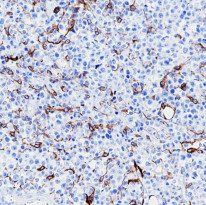ARG66673
anti-Podoplanin antibody [SQab19158]
anti-Podoplanin antibody [SQab19158] for IHC-Formalin-fixed paraffin-embedded sections and Human
Overview
| Product Description | Recombinant Rabbit Monoclonal antibody [SQab19158] recognizes Podoplanin |
|---|---|
| Tested Reactivity | Hu |
| Tested Application | IHC-P |
| Host | Rabbit |
| Clonality | Monoclonal |
| Clone | SQab19158 |
| Isotype | IgG |
| Target Name | Podoplanin |
| Antigen Species | Human |
| Immunogen | Synthetic peptide within aa. 1-100 of Human Podoplanin. |
| Conjugation | Un-conjugated |
| Alternate Names | T1A2; T1A; GP36; Aggrus; Gp38; T1A-2; Glycoprotein 36; PA2.26 antigen; TI1A; AGGRUS; HT1A-1; OTS8; Gp36; PA2.26; T1-alpha; Podoplanin; GP40 |
Application Instructions
| Application Suggestion |
|
||||
|---|---|---|---|---|---|
| Application Note | IHC-P: Antigen Retrieval: Heat mediation was performed in Tris/EDTA buffer (pH 9.0), primary antibody incubate at RT (18°C-25°C) for 30 minutes. * The dilutions indicate recommended starting dilutions and the optimal dilutions or concentrations should be determined by the scientist. |
Properties
| Form | Liquid |
|---|---|
| Purification | Purification with Protein A. |
| Buffer | PBS, 0.01% Sodium azide, 40% Glycerol and 0.05% BSA. |
| Preservative | 0.01% Sodium azide |
| Stabilizer | 40% Glycerol and 0.05% BSA |
| Storage Instruction | For continuous use, store undiluted antibody at 2-8°C for up to a week. For long-term storage, aliquot and store at -20°C. Storage in frost free freezers is not recommended. Avoid repeated freeze/thaw cycles. Suggest spin the vial prior to opening. The antibody solution should be gently mixed before use. |
| Note | For laboratory research only, not for drug, diagnostic or other use. |
Bioinformation
| Database Links | |
|---|---|
| Gene Symbol | PDPN |
| Gene Full Name | podoplanin |
| Background | This gene encodes a type-I integral membrane glycoprotein with diverse distribution in human tissues. The physiological function of this protein may be related to its mucin-type character. The homologous protein in other species has been described as a differentiation antigen and influenza-virus receptor. The specific function of this protein has not been determined but it has been proposed as a marker of lung injury. Alternatively spliced transcript variants encoding different isoforms have been identified. [provided by RefSeq, Jul 2008] |
| Function | May be involved in cell migration and/or actin cytoskeleton organization. When expressed in keratinocytes, induces changes in cell morphology with transfected cells showing an elongated shape, numerous membrane protrusions, major reorganization of the actin cytoskeleton, increased motility and decreased cell adhesion. Required for normal lung cell proliferation and alveolus formation at birth. Induces platelet aggregation. Does not have any effect on folic acid or amino acid transport. Does not function as a water channel or as a regulator of aquaporin-type water channels. [UniProt] |
| Cellular Localization | Podoplanin: Membrane; Single-pass type I membrane protein. Cell projection, lamellipodium membrane; Single-pass type I membrane protein. Cell projection, filopodium membrane; Single-pass type I membrane protein. Cell projection, microvillus membrane; Single-pass type I membrane protein. Cell projection, ruffle membrane; Single-pass type I membrane protein. Membrane raft. Apical cell membrane. Basolateral cell membrane. Cell projection, invadopodium. [UniProt] |
| Calculated MW | 17 kDa |
| PTM | Extensively O-glycosylated. Contains sialic acid residues. O-glycosylation is necessary for platelet aggregation activity. The N-terminus is blocked. [UniProt] |
Images (2) Click the Picture to Zoom In
-
ARG66673 anti-Podoplanin antibody [SQab19158] IHC-P image
Immunohistochemistry: Paraffin-embedded Human diffuse large B-cell lymphoma tissue stained with ARG66673 anti-Podoplanin antibody [SQab19158].
-
ARG66673 anti-Podoplanin antibody [SQab19158] IHC-P image
Immunohistochemistry: Formalin/PFA-fixed and paraffin-embedded Human lung tissue stained with ARG66673 anti-Podoplanin antibody [SQab19158]. Antigen Retrieval: Heat mediation was performed in Tris/EDTA buffer (pH 9.0).







